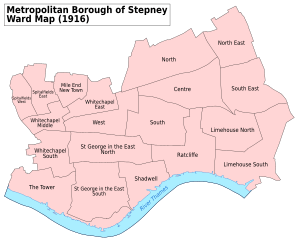Mile End (UK Parliament constituency) facts for kids
Quick facts for kids {{{Name}}}[[{{{Type}}} constituency]] |
|
|---|---|
| [[Image:{{{Map1}}}Constituency.svg|120px|]] [[Image:England{{{Map2}}}.svg|120px|]] |
|
| {{{Name}}} shown within [[{{{Entity}}}]], and {{{Entity}}} shown within England | |
| Created: | {{{Year}}} |
| MP: | {{{MP}}} |
| Party: | {{{Party}}} |
| Type: | House of Commons |
| County: | [[{{{County}}}]] |
| EP constituency: | [[{{{EP}}} (European Parliament constituency)|{{{EP}}}]] |
Mile End was a special area in the East End of London that used to elect its own representative to the Parliament of the United Kingdom. This representative is called a Member of Parliament (MP). An MP's job is to speak for the people in their area in the House of Commons.
This special area, or "constituency," was created for the election in 1885. It stopped being a separate constituency for the election in 1950.
Contents
What is a Parliamentary Constituency?
A parliamentary constituency is like a designated voting district. It's an area where people vote for one person to represent them in Parliament. Each constituency sends one MP to the House of Commons. This system makes sure that different parts of the country have a voice in how the country is run.
Mile End's Changing Borders
The borders of the Mile End constituency changed over time. These changes were important because they decided which areas and people the MP would represent.
Early Borders: 1885–1918
From 1885 to 1918, Mile End was part of a larger area called Tower Hamlets in east London. The constituency was focused on the community of Mile End, including the famous Mile End Road. A well-known local business was the Charrington Brewery. The head of this brewery, Spencer Charrington, was the MP for Mile End for many years.
Before 1885, Mile End was part of the county of Middlesex. Later, in 1889, a big change happened: the County of London was created. This meant Mile End became part of London's new administrative system. In 1900, London was divided into smaller areas called Metropolitan Boroughs. Mile End became part of the Metropolitan Borough of Stepney.
Later Borders: 1918–1950
The constituency's borders were updated again in 1918 by a law called the Representation of the People Act 1918. After this, Mile End became a division of Stepney. It included four local government areas of Mile End Old Town: Centre, North, South, and West. It also included the area of Whitechapel East.
In 1945, something unusual happened. Mile End became one of only two constituencies in the whole country to elect a Communist MP. His name was Phil Piratin, and he had been very active in the local community.
Finally, in 1950, the Mile End constituency was abolished. Its area then became part of the nearby Stepney constituency.
Members of Parliament for Mile End
The table below shows the people who were elected as Members of Parliament for Mile End. They represented the people of Mile End in the House of Commons during their time in office.
| Year | Member | Party | |
|---|---|---|---|
| 1885 | Spencer Charrington | Conservative | |
| 1905 | Harry Levy-Lawson | Liberal Unionist | |
| 1906 | Bertram Straus | Liberal | |
| 1910, January | Harry Levy-Lawson | Liberal Unionist a | |
| 1916 | Warwick Brookes | Unionist | |
| 1918 | Sir Walter Preston | Unionist b | |
| 1923 | John Scurr | Labour | |
| 1931 | William O'Donovan | Conservative | |
| 1935 | Daniel Frankel | Labour | |
| 1945 | Phil Piratin | Communist | |
| 1950 | constituency abolished | ||
Notes:-
- a The Liberal Unionist Party officially joined the Conservative Party in 1912.
- b This MP was part of a "Coalition Unionist" group from 1918 to 1922.
Images for kids









